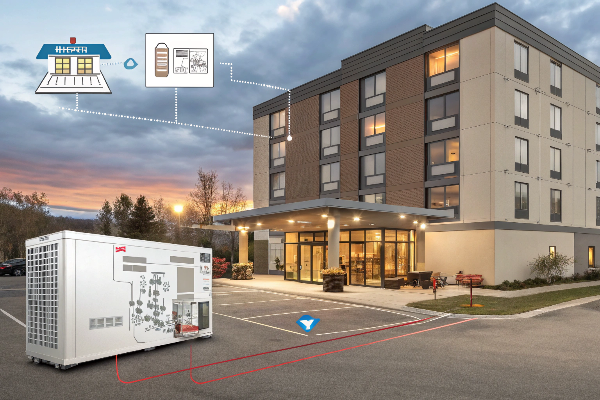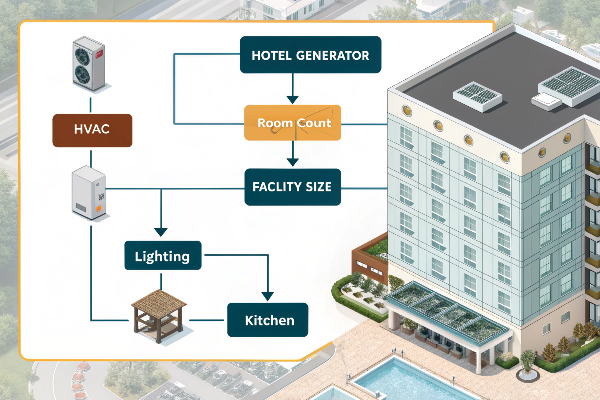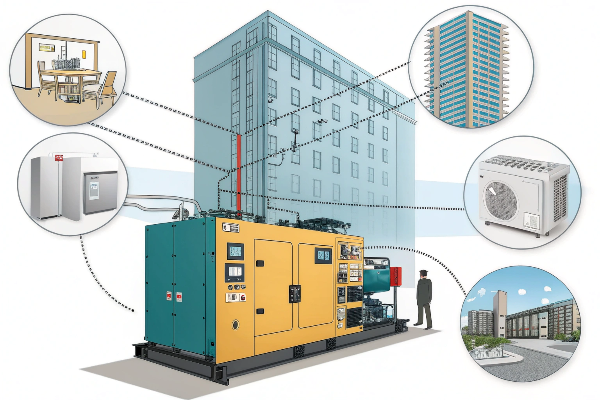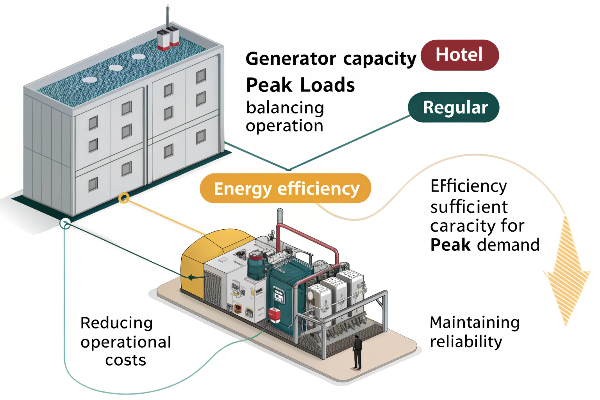
Choosing the right generator size for a hotel1 ensures uninterrupted power for guests, employees, and essential services. For a 72-room hotel, the generator needs to cover both the guest rooms and the supporting systems like HVAC, lighting, and kitchen equipment.
A 72-room hotel requires a generator that can handle both the continuous power demand and occasional peak loads, factoring in the entire facility’s electrical needs.
Here’s a guide to help you determine the right generator capacity for a hotel, considering its size and amenities.
How do you calculate the total power requirement for a hotel generator2 based on room count and facility size?
To determine the generator size for a 72-room hotel, you must consider the total power consumption of all electrical systems. This includes room-specific requirements as well as the power needs for common areas and amenities.
The calculation involves the total wattage of guest rooms, HVAC, lighting, kitchen, and other facilities within the hotel.

Key Steps to Calculate Total Power Requirement:
-
Estimate Power Consumption Per Room:
The average power consumption per hotel room depends on appliances like lighting, air conditioning, and small electronics.- Lighting: 150W per room
- Air Conditioning (AC): 1.5 kW per room
- Other Electronics (TV, mini-fridge, etc.): 500W per room
-
Calculate Total Power Consumption for Rooms:
Multiply the power consumption per room by the total number of rooms.[
\text{Total Power for Rooms} = (\text{Lighting} + \text{AC} + \text{Electronics}) \times \text{Number of Rooms}
]
[
\text{Total Power for Rooms} = (0.15 \, \text{kW} + 1.5 \, \text{kW} + 0.5 \, \text{kW}) \times 72 = 126 \, \text{kW}
] -
Include Power Consumption for Common Areas:
Common areas such as lobbies, elevators, conference rooms, and corridors typically consume an additional 15–20% of the total room load.[
\text{Power for Common Areas} = 126 \, \text{kW} \times 0.2 = 25.2 \, \text{kW}
] -
Factor in Kitchen Appliances and HVAC Systems:
The hotel kitchen and HVAC systems contribute significantly to power demand. Kitchens may require up to 10–15 kW for cooking equipment, refrigeration, and lighting. HVAC (heating, ventilation, and air conditioning) systems for the entire building can require around 50–100 kW depending on the hotel’s design.[
\text{Kitchen and HVAC Power} = 10 \, \text{kW} + 75 \, \text{kW} = 85 \, \text{kW}
] -
Total Power Requirement for the Hotel:
Adding up the room power, common area power, and kitchen/HVAC power gives the total load.[
\text{Total Power} = 126 \, \text{kW} + 25.2 \, \text{kW} + 85 \, \text{kW} = 236.2 \, \text{kW}
]
Convert to KVA:
To convert the power requirement from kW to KVA, divide by the power factor (typically 0.8).
[
\text{KVA} = \frac{236.2 \, \text{kW}}{0.8} \approx 295.25 \, \text{KVA}
]
So, a 300 KVA generator would be suitable to cover the total power requirement for a 72-room hotel.
What factors, such as HVAC, kitchen appliances, and backup systems, affect the generator size for a hotel?
Several key systems within the hotel contribute to its overall power demand. These factors must be carefully considered when sizing the generator to ensure it can handle peak loads and maintain consistent performance.
HVAC systems, kitchen appliances, elevators, and backup systems are critical components to include in the power calculation.

Key Factors Affecting Generator Size:
| Factor | Description | Impact on Generator Size |
|---|---|---|
| HVAC Systems | Includes air conditioning, heating, and ventilation systems. | HVAC systems are power-hungry, especially in large buildings, requiring a significant portion of the generator capacity. |
| Kitchen Appliances | Ovens, refrigerators, dishwashers, and other kitchen equipment. | Kitchens are high-demand areas with appliances that often require large surge power to start. |
| Elevators | Elevators for guest convenience. | Each elevator may require 5-10 kW during operation, plus surge power to start. |
| Lighting | Includes room lighting and common area lighting. | Lighting contributes to continuous load but is less significant than HVAC and kitchen appliances. |
| Backup Systems | Includes backup power for IT infrastructure, fire alarms, and other critical systems. | Backup systems need to be included to ensure uninterrupted operation during outages. |
| Laundry Facilities | Washing machines and dryers used for guest service. | Large hotel laundry facilities can consume 10–20 kW, depending on equipment size. |
Example:
A hotel kitchen with multiple ovens, fridges, and dishwashers could consume 10–15 kW of continuous power, while HVAC systems could add 50–100 kW depending on the facility’s size and design.
How can you optimize generator capacity3 to handle peak loads and energy efficiency in a hotel?
When selecting a generator, optimizing capacity for peak loads and ensuring energy efficiency are essential for reducing operational costs and maintaining reliability.
Optimizing generator capacity involves balancing efficiency during regular operation with enough headroom for peak demand.

Strategies for Optimizing Generator Capacity:
-
Choose a Generator with a 20–30% Margin:
It’s recommended to choose a generator with a capacity 20–30% larger than the calculated total power requirement to handle unexpected load spikes and ensure optimal operation.For example, if your total requirement is 300 KVA, a 350 KVA generator provides the necessary headroom for peak loads.
-
Implement Load Shedding Strategies:
During periods of high demand, some non-essential systems (like lighting or air conditioning in less-used areas) can be temporarily turned off or reduced in power to prevent overloading the generator. -
Use Multiple Smaller Generators for Load Balancing:
If feasible, using multiple smaller generators can provide flexibility. You can run them in parallel and distribute the load, reducing fuel consumption during periods of low demand and ensuring full capacity during peak demand. -
Consider Inverter Generators for Efficiency:
Inverter generators adjust their speed based on the load, providing more efficient fuel consumption. This is especially useful for facilities with fluctuating power demands. -
Regular Maintenance and Load Testing:
Perform regular maintenance to keep the generator running at peak efficiency, including checking oil levels, cleaning filters, and running load tests to ensure it can handle the full capacity when required. -
Optimize Energy Usage Across the Hotel:
- LED Lighting: Switching to energy-efficient LED lighting reduces power consumption in common areas.
- Smart HVAC Controls: Automated controls that adjust HVAC settings based on occupancy reduce unnecessary energy use.
Example:
- Hotel with a peak load of 350 KVA should use a 400 KVA generator.
- During off-peak hours, only two smaller generators (e.g., 200 KVA each) may be needed to save fuel, while the larger generator kicks in during peak times.
Conclusion
For a 72-room hotel, a 300 KVA generator can typically meet the power needs, covering guest rooms, HVAC, kitchen appliances, and common areas. Optimizing generator capacity involves allowing for peak demand, incorporating backup systems, and ensuring energy efficiency. A slightly larger generator provides flexibility for load spikes and ensures consistent operation during power outages.
-
Understanding how to size a generator for a hotel is crucial for ensuring reliable power supply. Explore this resource for expert insights. ↩
-
Calculating the total power requirement is essential for selecting the right generator. This link provides detailed guidance on the process. ↩
-
Optimizing generator capacity can lead to significant cost savings and efficiency. Discover effective strategies in this informative resource. ↩

